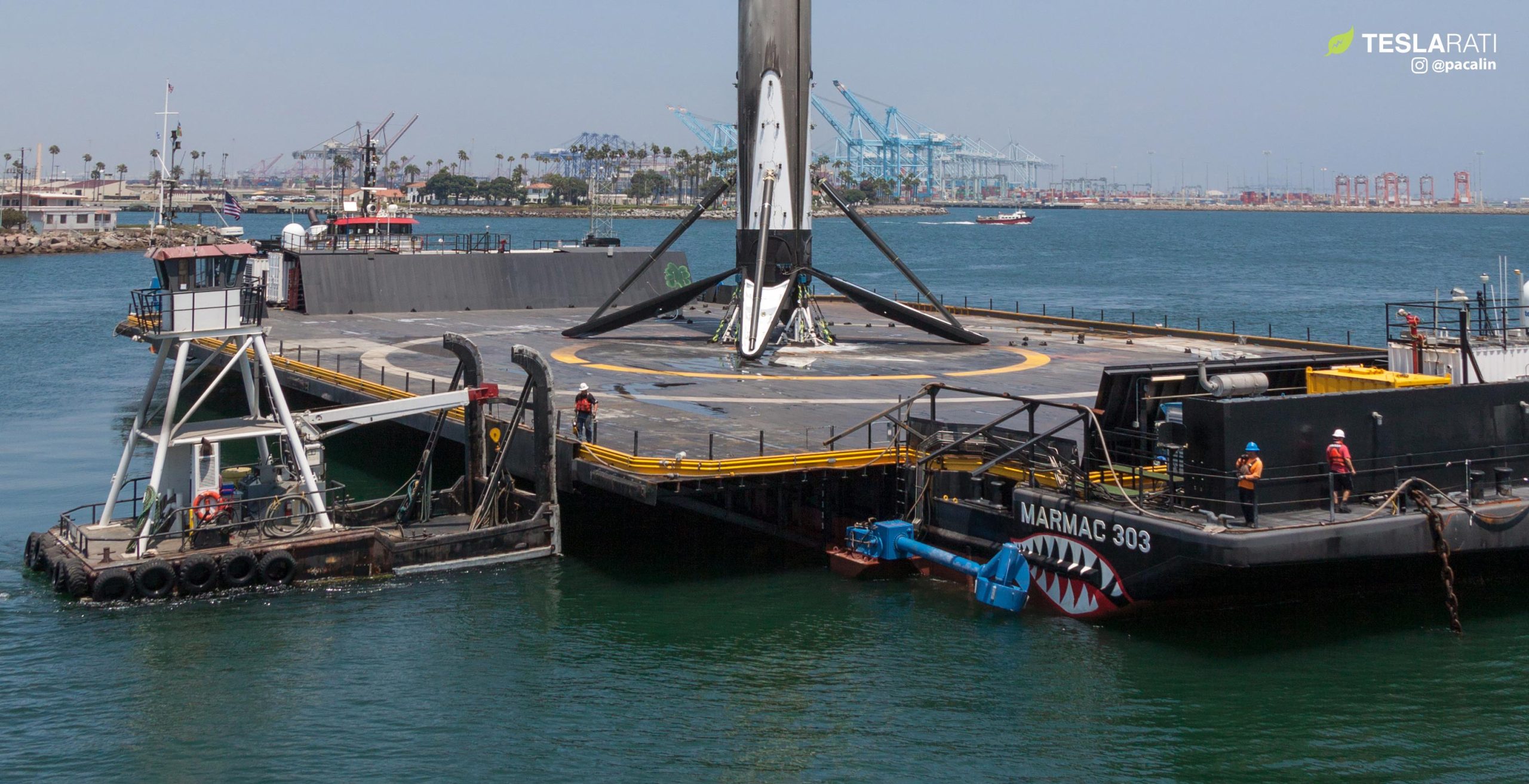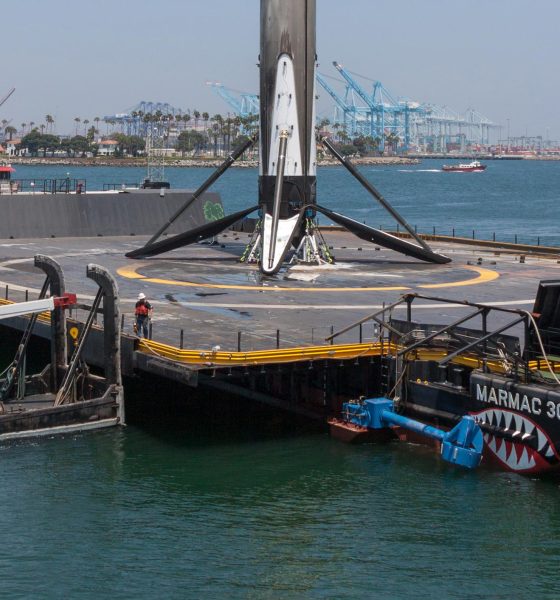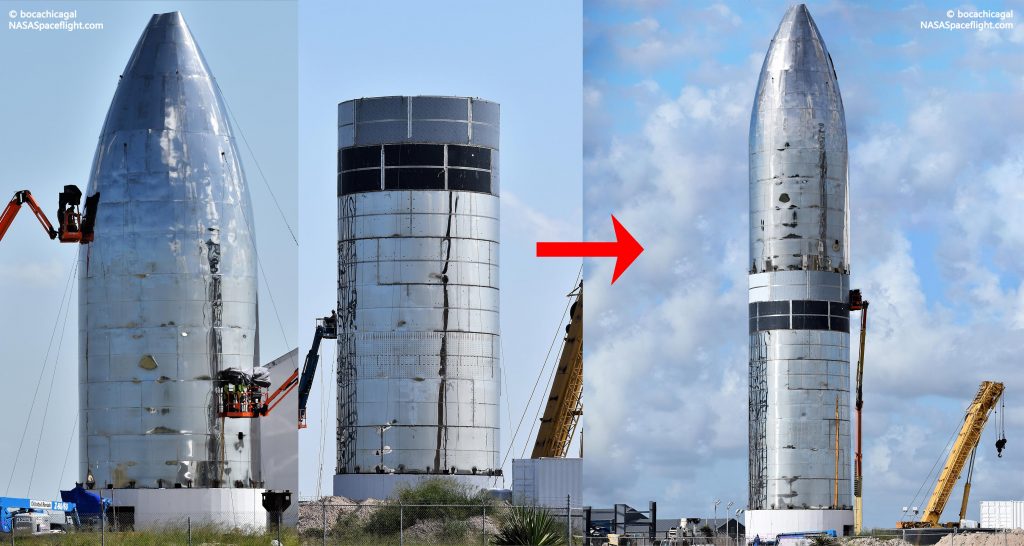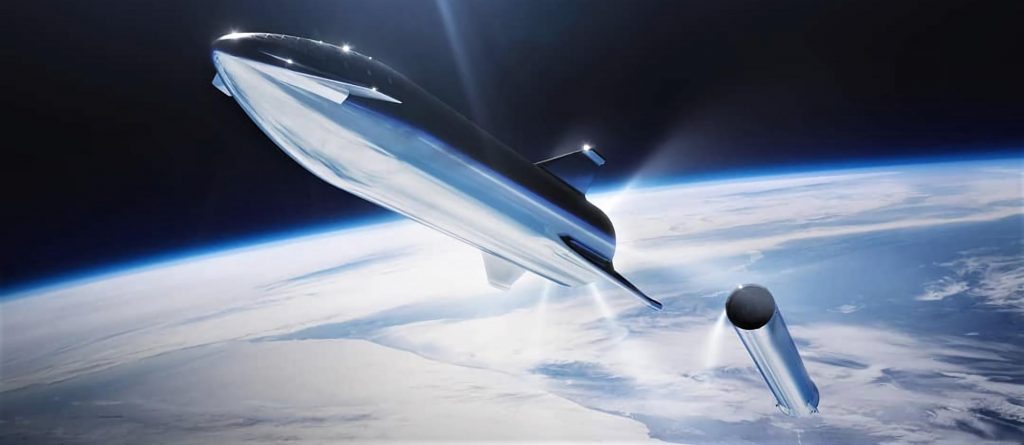

News
SpaceX’s West Coast drone ship begins Panama Canal transit on journey to Florida (or Texas)
After traveling more than 3500 miles (5600 km), SpaceX autonomous spaceport drone ship (ASDS) Just Read The Instructions (JRTI) began its eastbound transit of the Panama Canal on August 18th, placing the vessel roughly two-thirds of the way to its unknown destination.
As previously discussed on Teslarati, JRTI’s move came as a bit of a surprise and it’s still anyone’s bet if the SpaceX recovery vessel heads for Texas or Florida immediately after exiting the Panama Canal. Nevertheless, JRTI’s presence at either (or, more likely, both) possible destinations arguably centers around the imminent demands of a planned ramp of SpaceX’s Starlink satellite constellation launch cadence, as well as an equally imminent need for recovery assets to support the first suborbital Starship test flights.
On July 31st, JRTI departed Port of Los Angeles – its home for the last four years – under tow behind tugboat Alice C. The duo arrived at the Canal on August 15th and, after a several-day wait in a large passage queue, the drone ship and its paired tugboat are finally on their way through the canal, although traffic still remains high and another day (or several) of waiting is likely in order.
After successfully making it through the first half of the transit, JRTI and Alice C are currently waiting in line while westbound traffic is routed through. That wait will likely last hours, not days, (hopefully) allowing JRTI to exit the canal on Tuesday or Wednesday, leaving drone ship free to head towards its final destination.
JRTI has two possible destinations: Port of Brownsville, Texas or Port Canaveral, Florida. Both options are roughly 1800 mi (3000 km) from the Panama Canal’s western mouth and, extrapolating from the first major leg of the journey, should take Alice C around 8 days to tow JRTI across the finish line. Barring mishaps, the drone ship should thus be able to arrive at its new home sometime in the final week of August – roughly August 27th to the 31st.
To the East, to the Gulf
As previously discussed on Teslarati, there are good cases to make for both potential drone ship destinations. On the East Coast, SpaceX’s plans to ramp up its internal Starlink launch cadence could require multiple drone ship to prevent those ambitions from seriously impacting the company’s commercial launch manifest. The readiness of one or two of the payloads is uncertain, but SpaceX has anywhere from seven to nine Falcon 9 launches scheduled in Q4 2019, requiring a cadence significantly higher than SpaceX’s activity in the first half of 2019.
At the same time, extrapolating from SpaceX’s H1 2019 cadence (1.33 launches per month), more than doubling that average cadence to 3 launches per month in the final quarter seems ambitious, at a minimum. SpaceX has achieved six-launch quarters several times in the last few years, likely a reasonable expectation for Q4 2019. In short, this is all to say that SpaceX has made do with one drone ship in the past while hitting similar launch cadences, meaning that the need for JRTI at Port Canaveral is probably not urgent.
On the Gulf Coast, SpaceX has established a Starship development facility in Boca Chica, Texas, just a handful of miles north of the southernmost tip of Texas. A full-scale, low-fidelity prototype known as Starhopper completed its first test flight on July 25th and is likely just days away from a second test flight. Meanwhile, SpaceX Boca Chica is simultaneously assembling what CEO Elon Musk has described as the “Mk1” orbital Starship prototype and is making spectacularly rapid progress.

Musk recently tweeted that SpaceX’s Mk1 Starship and a second parallel build – Starship Mk2 – could be ready for their first (suborbital) flights as early as late-September or October, followed by one of the spacecraft’s first orbital launch attempt an incredibly ambitious “2-3 months after” the first test flight. Per additional statements from Musk in 2018 and 2019, SpaceX plans to subject either or both of its Mk1 and Mk1 Starships to a high-altitude, high-velocity test program before proceeding to orbital launch attempts.
Said extreme testing could easily involve Starship traveling on high suborbital trajectories dozens or even hundreds of miles above Earth’s surface, potentially demanding an ocean-going landing platform far downrange. Given that Starship is in its very early stages of integrated development, any downrange assets (i.e. JRTI) needed for test flights will need to be very flexible, as Starship launch attempts could easily slip days or weeks with little to no notice.

Best of both worlds
Although pitting options against each other is entertaining and has its uses, the fact remains that once drone ship JRTI has passed through the Panama Canal, traveling from, say, Florida to Texas or vice versa is far less arduous a journey than the trip from Port of LA. In other words, moving JRTI between Port of Brownsville and Port Canaveral every few months should be very little trouble, easily allowing the drone ship to service both Gulf and East Coast recovery needs.
Given that SpaceX’s next Falcon 9 launch is believed to be no earlier than late-October, it’s not even out of the question that JRTI will stop in Brownsville for one month or several before heading to Port Canaveral as SpaceX attempts to complete a very busy Q4 2019 launch manifest. Stay tuned…
Check out Teslarati’s Marketplace! We offer Tesla accessories, including for the Tesla Cybertruck and Tesla Model 3.

News
Tesla FSD fleet is nearing 7 billion total miles, including 2.5 billion city miles
As can be seen on Tesla’s official FSD webpage, vehicles equipped with the system have now navigated over 6.99 billion miles.

Tesla’s Full Self-Driving (Supervised) fleet is closing in on almost 7 billion total miles driven, as per data posted by the company on its official FSD webpage.
These figures hint at the massive scale of data fueling Tesla’s rapid FSD improvements, which have been quite notable as of late.
FSD mileage milestones
As can be seen on Tesla’s official FSD webpage, vehicles equipped with the system have now navigated over 6.99 billion miles. Tesla owner and avid FSD tester Whole Mars Catalog also shared a screenshot indicating that from the nearly 7 billion miles traveled by the FSD fleet, more than 2.5 billion miles were driven inside cities.
City miles are particularly valuable for complex urban scenarios like unprotected turns, pedestrian interactions, and traffic lights. This is also the difference-maker for FSD, as only complex solutions, such as Waymo’s self-driving taxis, operate similarly on inner-city streets. And even then, incidents such as the San Francisco blackouts have proven challenging for sensor-rich vehicles like Waymos.
Tesla’s data edge
Tesla has a number of advantages in the autonomous vehicle sector, one of which is the size of its fleet and the number of vehicles training FSD on real-world roads. Tesla’s nearly 7 billion FSD miles then allow the company to roll out updates that make its vehicles behave like they are being driven by experienced drivers, even if they are operating on their own.
So notable are Tesla’s improvements to FSD that NVIDIA Director of Robotics Jim Fan, after experiencing FSD v14, noted that the system is the first AI that passes what he described as a “Physical Turing Test.”
“Despite knowing exactly how robot learning works, I still find it magical watching the steering wheel turn by itself. First it feels surreal, next it becomes routine. Then, like the smartphone, taking it away actively hurts. This is how humanity gets rewired and glued to god-like technologies,” Fan wrote in a post on X.
News
Tesla starts showing how FSD will change lives in Europe
Local officials tested the system on narrow country roads and were impressed by FSD’s smooth, human-like driving, with some calling the service a game-changer for everyday life in areas that are far from urban centers.

Tesla has launched Europe’s first public shuttle service using Full Self-Driving (Supervised) in the rural Eifelkreis Bitburg-Prüm region of Germany, demonstrating how the technology can restore independence and mobility for people who struggle with limited transport options.
Local officials tested the system on narrow country roads and were impressed by FSD’s smooth, human-like driving, with some calling the service a game-changer for everyday life in areas that are far from urban centers.
Officials see real impact on rural residents
Arzfeld Mayor Johannes Kuhl and District Administrator Andreas Kruppert personally tested the Tesla shuttle service. This allowed them to see just how well FSD navigated winding lanes and rural roads confidently. Kruppert said, “Autonomous driving sounds like science fiction to many, but we simply see here that it works totally well in rural regions too.” Kuhl, for his part, also noted that FSD “feels like a very experienced driver.”
The pilot complements the area’s “Citizen Bus” program, which provides on-demand rides for elderly residents who can no longer drive themselves. Tesla Europe shared a video of a demonstration of the service, highlighting how FSD gives people their freedom back, even in places where public transport is not as prevalent.
What the Ministry for Economic Affairs and Transport says
Rhineland-Palatinate’s Minister Daniela Schmitt supported the project, praising the collaboration that made this “first of its kind in Europe” possible. As per the ministry, the rural rollout for the service shows FSD’s potential beyond major cities, and it delivers tangible benefits like grocery runs, doctor visits, and social connections for isolated residents.
“Reliable and flexible mobility is especially vital in rural areas. With the launch of a shuttle service using self-driving vehicles (FSD supervised) by Tesla in the Eifelkreis Bitburg-Prüm, an innovative pilot project is now getting underway that complements local community bus services. It is the first project of its kind in Europe.
“The result is a real gain for rural mobility: greater accessibility, more flexibility and tangible benefits for everyday life. A strong signal for innovation, cooperation and future-oriented mobility beyond urban centers,” the ministry wrote in a LinkedIn post.
News
Tesla China quietly posts Robotaxi-related job listing
Tesla China is currently seeking a Low Voltage Electrical Engineer to work on circuit board design for the company’s autonomous vehicles.

Tesla has posted a new job listing in Shanghai explicitly tied to its Robotaxi program, fueling speculation that the company is preparing to launch its dedicated autonomous ride-hailing service in China.
As noted in the listing, Tesla China is currently seeking a Low Voltage Electrical Engineer to work on circuit board design for the company’s autonomous vehicles.
Robotaxi-specific role
The listing, which was shared on social media platform X by industry watcher @tslaming, suggested that Tesla China is looking to fill the role urgently. The job listing itself specifically mentions that the person hired for the role will be working on the Low Voltage Hardware team, which would design the circuit boards that would serve as the nervous system of the Robotaxi.
Key tasks for the role, as indicated in the job listing, include collaboration with PCB layout, firmware, mechanical, program management, and validation teams, among other responsibilities. The role is based in Shanghai.
China Robotaxi launch
China represents a massive potential market for robotaxis, with its dense urban centers and supportive policies in select cities. Tesla has limited permission to roll out FSD in the country, though despite this, its vehicles have been hailed as among the best in the market when it comes to autonomous features. So far, at least, it appears that China supports Tesla’s FSD and Robotaxi rollout.
This was hinted at in November, when Tesla brought the Cybercab to the 8th China International Import Expo (CIIE) in Shanghai, marking the first time that the autonomous two-seater was brought to the Asia-Pacific region. The vehicle, despite not having a release date in China, received a significant amount of interest among the event’s attendees.








